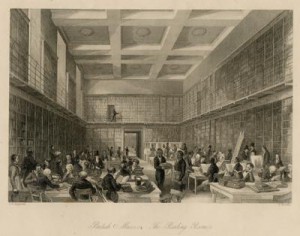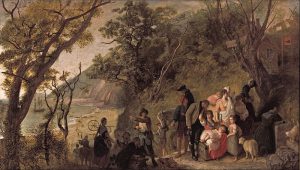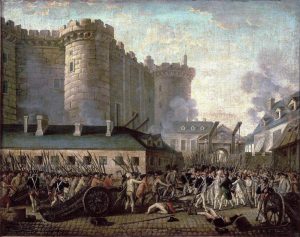Tuesday, January 7th
Course Introduction
Thursday, January 9th
Introduction to the Eighteenth Century (xxxiii-lxix)
John Locke, “Of Ideas” from An Essay Concerning Human Understanding, 1689 (BABL 18th-C: 159-160)
Isaac Newton, Letter to Richard Bentley, 10 December 1692 (BABL 18th-C: 177-179)
James Thomson, excerpted stanzas from “A Poem Sacred to the Memory of Sir Isaac Newton,” 1727 (BABL 18th-C: 179-180)
Mark Akenside, “Hymn to Science,” 1739 (BABL 18th-C: 180-181)
Literary Terms: ode, hymn, stanza, blank verse, essay. Other terms discussed in class today: parallelism, zeugma, anaphora.
For further information, read: Rhetorical Figures
Another definition of anaphora: “A rhetorical device involving the repetition of a word or group of words in successive clauses” (from The Penguin Dictionary of Literary Terms and Literary Theory, 4th edition 37)
In-class writing: Discuss one aspect of eighteenth-century English history/culture/science that you read about in today’s prose reading (i.e. the BroadviewiIntroduction, Locke and/or Newton) to at least one of the poems that you also read. Support your assertion by quoting specifically from the reading (i.e. prose and poetry). After you cite your evidence, provide one sentence describing how your evidence supports your assertion(s)/argument.
**
Tuesday, January 14th
Pope, from An Essay on Man, including “The Design” and Epistle 1, 1733, (BABL 18th-C: 575-579) <Outline of An Essay on Man>
Literary Terms: essay; antithesis; apostrophe; rhetorical questions, alliteration; heroic couplet and other Rhetorical Figures: zeugma, chiasmus, parallelism, anaphora (click on link for definitions and examples);
Another definition of anaphora: “A rhetorical device involving the repetition of a word or group of words in successive clauses” (from The Penguin Dictionary of Literary Terms and Literary Theory, 4th edition 37)
Thursday, January 16th
Addison, from The Spectator, No. 69 (May 19, 1711) (BABL 18th-C: 914-916)
Defoe, “On Trade,” 1726, (BABL 18th-C: 916-917)
Thomson, “Rule, Britannia,” 1740 (BABL 18th-C: 715)
from William Morlay, The Infortunate, 1743 (BABL 18th-C: 840-842)
Elizabeth Hands, “On the Supposition of an Advertisement Appearing in a Morning Paper, of the Publication of a Volume of Poems, by a Servant Maid”, 1789 (BABL 18th-C: 902-903)
**
Tuesday, January 21st
Oliver Goldsmith, The Deserted Village, 1770 (BABL 18th-C: 873-878)
<Outline of The Deserted Village>
1770 edition of the poem at the British Library
Literary Terms: metaphor and simile, symbol and personification
Writing Prompt: Briefly discuss Pope’s Essay on Man in relation to Goldsmith’s The Deserted Village, paying attention to differences in at least one of the following: tone, poetic form, and the role of the speaker.
Thursday, January 23rd
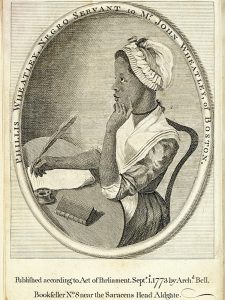 Phillis Wheatley, “To the Right Honorable William, Earl of Dartmouth,” “To the King’s Most Excellent Majesty,” and “A Farewell to America: To Mrs. S. W.” 1768-1773 (BABL 18th-C: 1017-1018)
Phillis Wheatley, “To the Right Honorable William, Earl of Dartmouth,” “To the King’s Most Excellent Majesty,” and “A Farewell to America: To Mrs. S. W.” 1768-1773 (BABL 18th-C: 1017-1018)
from Benjamin Franklin, Information to Those Who Would Remove to America, 1782 (BABL 18th-C: 846-48)
Richard Price, from Observations on the Importance of the American Revolution, 1785 (BABL 18th-C: 871)
Olaudah Equiano or Gustavus Vassa, from The Interesting Narrative of the Life of Olaudah Equiano, Chapter 2, 1789 (BABL (18th-C: 953-968)
**
Tuesday, January 28th
The French Revolution: Contexts, Selections from Richard Price, Edmund Burke, Mary Wollstonecraft, Thomas Paine, and William Godwin 1789-1793 (BABL B 53-73)
Mary Wollstonecraft, READ ONLY from the Introduction to A Vindication of the Rights of Woman, 1792 (BABL B 105-108), and the selection from Chapter Three (121)
“It is time to effect a revolution in female manners — time to restore to them their lost dignity — and make them, as a part of the human species, labor by reforming themselves to reform the world” (Chapter III)
Thursday, January 30th
Poetry Day: “Reading Poetry” (BABL B 1836-1857) 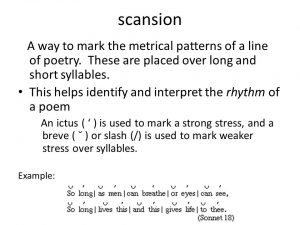
“Poetry both represents and creates emotions in a highly condensed way” (1612)
“a poem is a discourse that is characterized by a heightened attention to language, form, and rhythm, by an expressiveness that works through figurative rather than literal modes, and by a capacity to stimulate our imagination and arouse our feelings” (1836)
How to Analyze Poetry and The Metrical Foot
Poetry Exercises: Please print up 2 copies. Bring 1 copy in that you have completed and 1 copy that is blank. <Poetry Exercise>
**
